Creating a Deployment
Overview
A Deployment is the task responsible for sending and uploading a configuration into a device group. Even though configurations are available to all sites in the account, deployments are tasks which are limited to the site they are created in. It is possible to plan several deployments into the future, for instance, one for Monday morning and one for that afternoon.
![]()
A deployment always implies the previous creation of a configuration and a device group.
For more detailed information, see Creating a Configuration and Creating a Device Group.
![]() Before creating a new deployment, check the "Deployment Plans" page to avoid creating incompatibilities or duplicated deployments.
Before creating a new deployment, check the "Deployment Plans" page to avoid creating incompatibilities or duplicated deployments.
Step-by-step
1. To access the Deployments sub-module, click ![]() (in the Control Panel) and, in the resulting row below, click
(in the Control Panel) and, in the resulting row below, click ![]() .
.
This opens the "Deployment Plans" page.

2. Click ![]() to open a "New Deployment Plan" page. The page is in "edit" mode.
to open a "New Deployment Plan" page. The page is in "edit" mode.
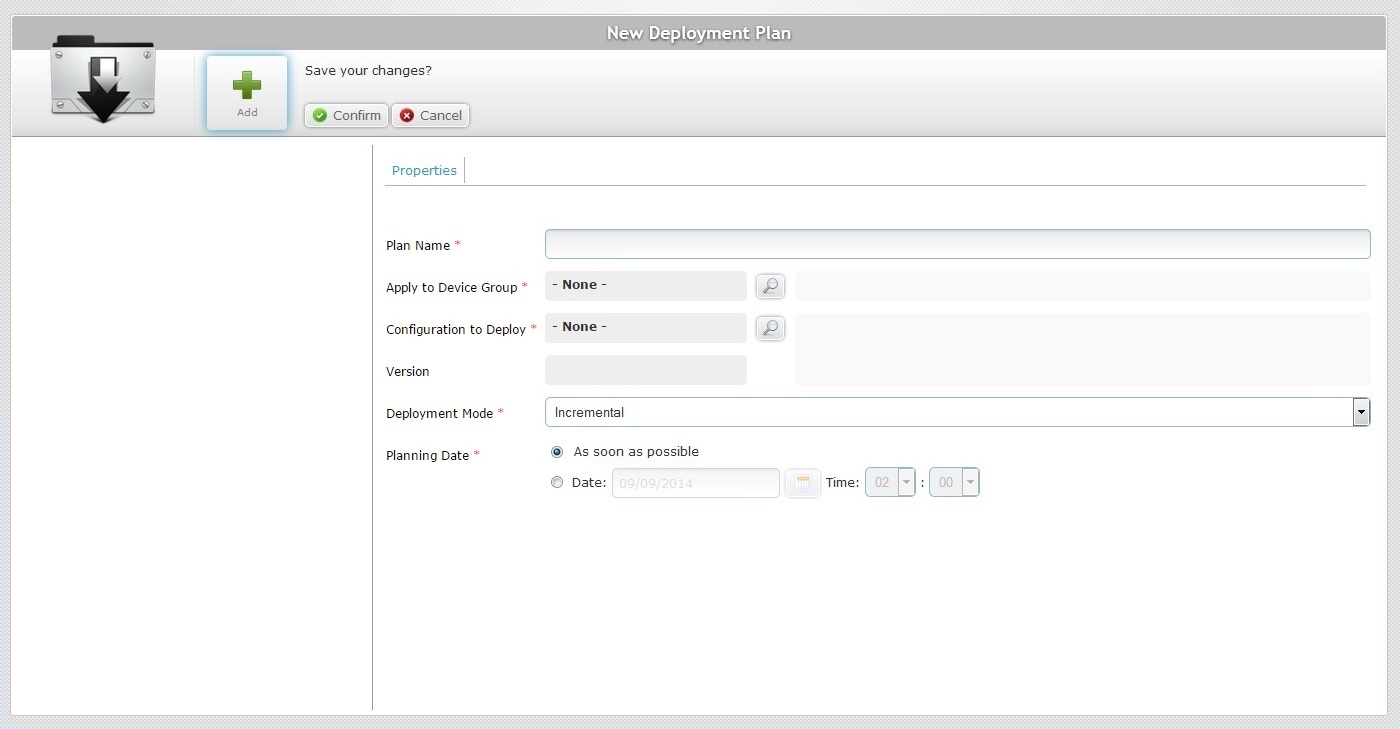
3. Fill in the available options (the fields marked with an asterisk are mandatory):
Plan Name * |
Enter a name for the new deployment (minimum of 4 characters).
•Use alphabetic/numeric characters (a-z; A-Z; 0-9) •Underscore and/or dash characters are allowed •Always start the entity's name with an alphabetic character |
||||||||||
|---|---|---|---|---|---|---|---|---|---|---|---|
Apply to Device Group * |
Click the corresponding |
||||||||||
Configuration to Deploy * |
Click the corresponding |
||||||||||
Version |
The selected configuration's version. This field is NOT editable, it is automatically filled in once a configuration is selected. |
||||||||||
Deployment Mode * |
Select the most appropriate deployment mode from the drop-down list: Incremental: only components present in the deployed configuration, that are not present in the device, will be implemented. Full Install: deletes all the MCL applications/firmware and forces the installation of the components present in the deployed configuration.
Check the following examples:
Due to their multipurpose nature, Misc files are an exception. No matter what the selected deployment mode (“Incremental” or “Full Install”), deployed misc files are NOT removed from the target device, they are added to it. |
||||||||||
Planning Date * |
Check the most appropriate scheduling for the deployment: As soon as possible: the deployment will happen as soon as the device contacts the account and the deployment criteria are met. Date: Click |
4. After defining all the available details in the "New Deployment Plan" page, click ![]() .
.
Check the Possible Error Message(s), if an error occurs.
Detail of a Select a Device Group window
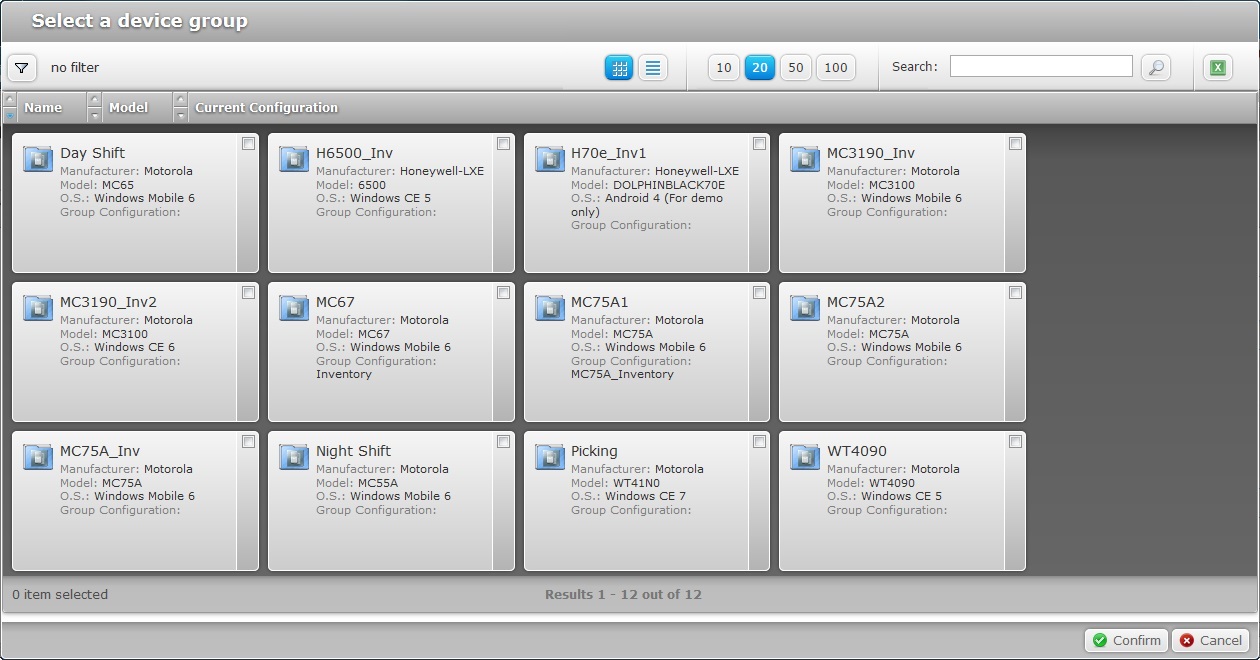
To select a device group, proceed as follows:
a. In the "New Deployment Plan" page, click the ![]() button of the "Apply to Device Group" option. This opens a "Select a Device Group" window with the available device groups.
button of the "Apply to Device Group" option. This opens a "Select a Device Group" window with the available device groups.
b. Select the target device group by checking the corresponding ![]() .
.
c. Click ![]() to conclude and return to the "New Deployment Plan" page.
to conclude and return to the "New Deployment Plan" page.
Use the following options to control the display of listed items:
•Select the most appropriate view by either clicking the grid view ![]() (default option)or the list view
(default option)or the list view ![]() :
:
•Define how many items are displayed, at a time, by clicking one of the buttons![]() .
.
•![]() Use the search box to filter the information:
Use the search box to filter the information:
a. Enter what you want to search for.
b. Click ![]() or press <ENTER> in your PC keyboard to initiate the search.
or press <ENTER> in your PC keyboard to initiate the search.
c. To conclude the search operation, empty the search box and click ![]() or press <ENTER> in your PC keyboard.
or press <ENTER> in your PC keyboard.
If required, use ![]() to export a list with the device groups:
to export a list with the device groups:
a. Click ![]() .
.
b. Click ![]() in the resulting window.
in the resulting window.
The device group list is exported with an Excel file format.
The conclusion of the export operation depends on the web browser used. You should be able to save the Excel file in your PC or open it directly after the download.
Detail of a Select a Configuration window
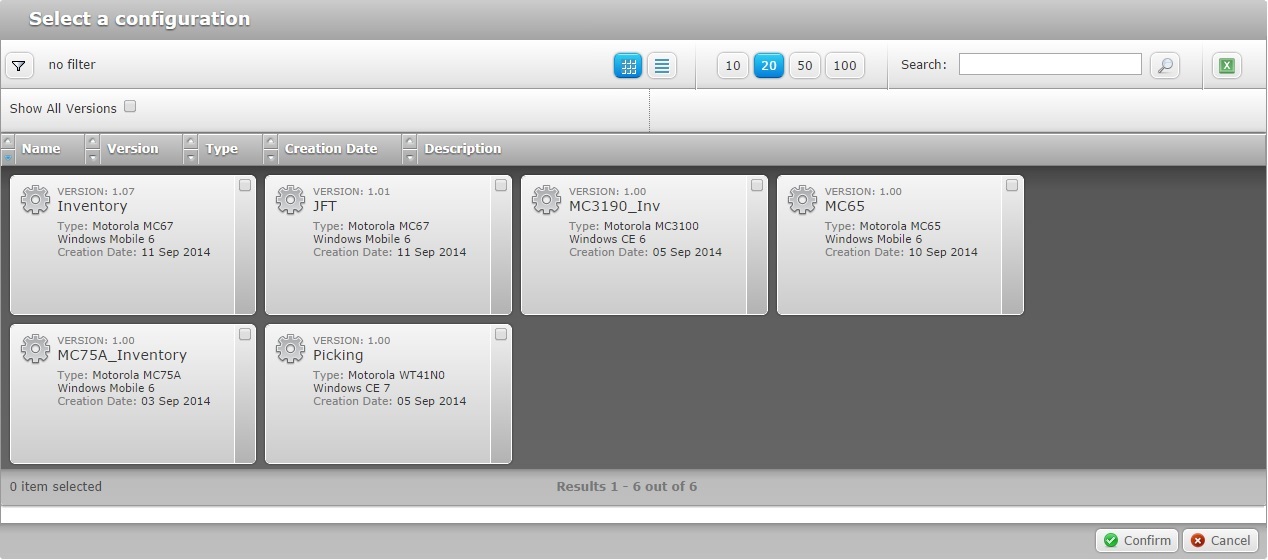
To select a configuration, proceed as follows:
a. In the "New Deployment Plan" page, click the ![]() button of the "Configuration to Deploy" option. This opens the "Select a Configuration" window with each configuration's latest version.
button of the "Configuration to Deploy" option. This opens the "Select a Configuration" window with each configuration's latest version.
If you want to view all configuration versions, click ![]() to access the
to access the ![]() option and check it.
option and check it.
b. Select a configuration by checking the corresponding ![]() (the list only displays compatible configurations for the previously selected device group).
(the list only displays compatible configurations for the previously selected device group).
c. Click ![]() to conclude and return to the "New Deployment Plan" page.
to conclude and return to the "New Deployment Plan" page.
Use the following options to control the display of listed items:
•Select the most appropriate view by either clicking ![]() for a grid view (default option) or
for a grid view (default option) or ![]() for a list view:
for a list view:
•Define how many items are displayed, at a time, by clicking one of the buttons![]() .
.
•![]() Use the search box to filter the information:
Use the search box to filter the information:
a. Enter what you want to search for.
b. Click ![]() or press <ENTER> in your PC keyboard to initiate the search.
or press <ENTER> in your PC keyboard to initiate the search.
c. To conclude the search operation, empty the search box and click ![]() or press <ENTER> in your PC keyboard.
or press <ENTER> in your PC keyboard.
If required, use ![]() to export a list with the available configurations:
to export a list with the available configurations:
a. Click ![]() .
.
b. Click ![]() in the resulting window.
in the resulting window.
The configuration list is exported with an Excel file format.
The conclusion of the export operation depends on the web browser used. You should be able to save the Excel file in your PC or open it directly after the download.
![]()
Deployments can be planned in other contexts and sub-modules. If you use any of the options below, you also open a "New Deployment Plan" page:
•In the "Deployment Plans" page, click the name of a planned deployment ("Plan Name" displayed in light blue) and edit its details. For more information, see Editing a Deployment.
•In the "Configurations" page, click ![]() . For more information, see Assigning a Configuration to a Device Group.
. For more information, see Assigning a Configuration to a Device Group.
•In the "Device Groups" page, click ![]() . For more information, see Planning a Deployment for a Device Group.
. For more information, see Planning a Deployment for a Device Group.
![]()
Occurrence: When clicking ![]() .
.
Cause: No deployment name defined.
Action: Define a deployment name ( with at least 4 characters) and, then, click ![]() .
.
![]()
Occurrence: When clicking ![]() .
.
Cause: The deployment's name is less than 4 characters long.
Action: Enter a deployment name with 4 or more characters and, then, click ![]() .
.
![]()
Occurrence: When clicking ![]() in the "New Deployment Plan" page.
in the "New Deployment Plan" page.
Cause: No device group is selected.
Action: Click the ![]() button of the "Apply to Device Group" option, select a target device group in the "Select a Device Group" window and, then, click
button of the "Apply to Device Group" option, select a target device group in the "Select a Device Group" window and, then, click ![]() to apply.
to apply.
![]()
Occurrence: When clicking ![]() in the "New Deployment Plan" page.
in the "New Deployment Plan" page.
Cause: No configuration is selected.
Action: Click the ![]() button of the "Configuration to Deploy" option, select a configuration in the "Select a Configuration" window and, then, click
button of the "Configuration to Deploy" option, select a configuration in the "Select a Configuration" window and, then, click![]() to apply.
to apply.
At Device Level
Once a deployment is created, and depending on the selected “Planning Date” option ("as soon as possible" or a specific date), all the devices belonging to the selected device group will receive the defined configuration as soon as they are logged on. Depending on the device's Operating System (Windows Mobile or Android), the deployment's screen sequence will be different:
Screen Sequence of a Deployment in a Windows Mobile Device
![]() The deployments will only start if the target device fulfills the default deployment criteria (more than 20% of battery power, more than 20% WWAN/WLAN network coverage, with an open App-Desktop or, if an application is open, the deployment will only start if the application is idle for more than 1 minute).
The deployments will only start if the target device fulfills the default deployment criteria (more than 20% of battery power, more than 20% WWAN/WLAN network coverage, with an open App-Desktop or, if an application is open, the deployment will only start if the application is idle for more than 1 minute).
![]() Each device must have MCL-Agent already installed. For more information, see Installing MCL-Agent into a Windows Mobile Device OR Installing MCL-Agent into an Android Device.
Each device must have MCL-Agent already installed. For more information, see Installing MCL-Agent into a Windows Mobile Device OR Installing MCL-Agent into an Android Device.
![]() If a previous deployment has been performed, the MCL-Client logo (
If a previous deployment has been performed, the MCL-Client logo (![]() ) will be in the device's display. Otherwise, it will only be displayed after the first deployment.
) will be in the device's display. Otherwise, it will only be displayed after the first deployment.
1. Initial App Desktop state before starting the deployment.
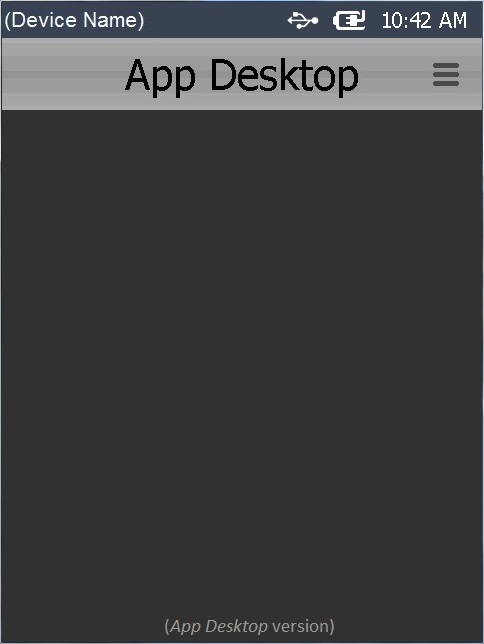
2. Once the deployment is concluded, if the deployment includes an application, the App Desktop displays that application's shortcut icon.
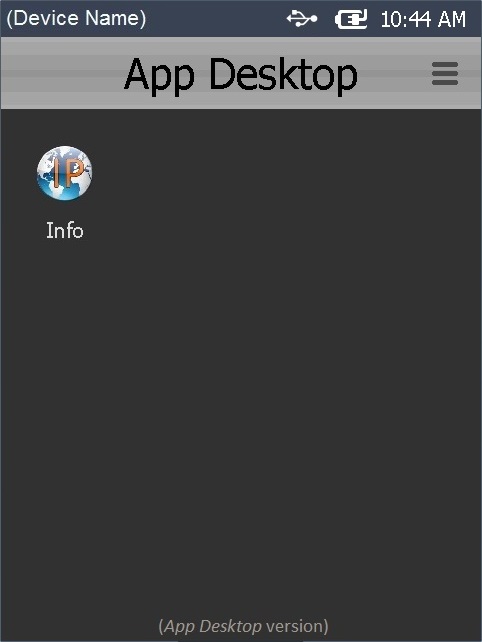
Screen Sequence of a Deployment in an Android Device
![]() Each device must have MCL-Agent already installed. For more information, see Installing MCL-Agent into an Android Device.
Each device must have MCL-Agent already installed. For more information, see Installing MCL-Agent into an Android Device.
1. Initial App Desktop state before starting the deployment.
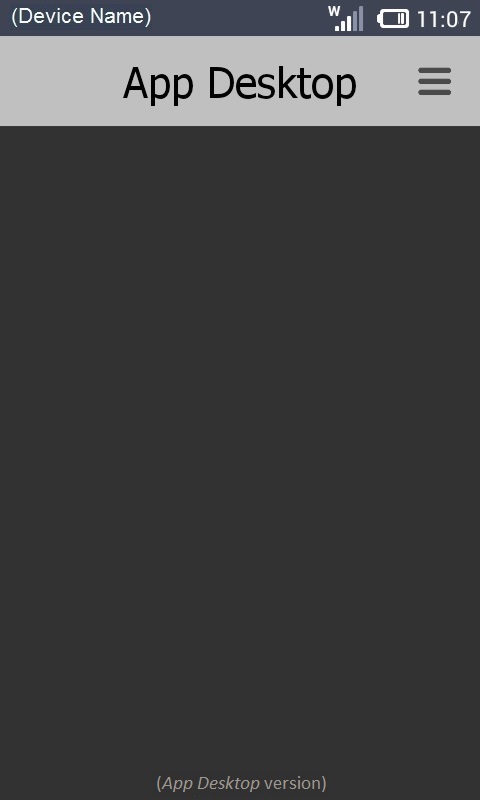
2. Once the deployment criteria are met, the App Desktop closes and displays the last OS open area.
(The deployment downloads and installs its components.)

3. The App Desktop starts again.

4. Final App Desktop state once the deployment is finished.
If the deployment includes an application, the App Desktop displays that application's shortcut icon.
